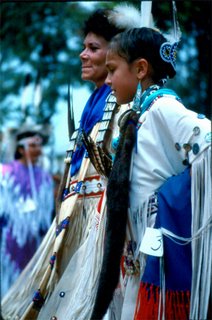American Indian Influence in the Blue Ridge

Spring is on its way, and as you travel the Blue Ridge Parkway this spring and summer, look for the ruminants of our Native American friends. The Blue Ridge Parkway extends nearly 500 miles along the crest of the Blue Ridge Mountains through North Carolina and Virginia; it encompasses some of the oldest settlements of pre-historic Native Americans.
The Cherokee Indians of North Carolina, and the Monacan and the now extinct, Saponi, and Tutelo Indians of western Virginia, were among the earliest inhabitants of the Blue Ridge, leaving artifacts and changes in the landscape as evidence of their existence.
Many of the fields that are still visible at the base of the mountains date back centuries, to ancient American Indian agricultural methods of burning and deadening the trees and underbrush to provide needed grazing and crop land. Mountain and river names along the Parkway also reflect the American Indian influence.

One of the best places to learn about the pre-history of the Appalachian chain in Virginia, is at the Peaks of Otter Visitor Center museum (milepost 85.9). Arrowheads and early tools found in the Peaks area are exhibited.
In North Carolina, the Parkway enters the Cherokee Indian Reservation at milepost 457.7 and features an informational display on the reservation at the Lickstone Overlook (milepost 458.9).
Images: by D L Ennis, Dancers at a Monacan Powwow
Attend the 14th Annual Monacan Powwow May 20 & 21, 2006. Click the link for more information.
Technorati Tags: [Blue Ridge Parkway][North Carolina][Virginia][Native American][Cherokee][Monacan][American Indian][Peaks of Otter][Lickstone Overlook][Cherokee Indian Reservation]

2 Comments:
At Friday, 24 February, 2006, The MacBean Gene said…
The MacBean Gene said…
My wife and I met a fellow in Woodlawn who had been finding arrowheads and such for a number of years and had an incredable collection including three beautiful crystal quartz arrowheads. It was his second collection, he said he got drunk and pawned the first!
At Friday, 24 February, 2006, Leslie Shelor said…
Leslie Shelor said…
When John Shelor came to Meadows of Dan in about 1820, he said that there had been a great fire and the undergrowth had just grown back to the height of a deer's shoulder. He came here hunting wolves for bounty. There aren't many signs of Native American settlement right in this area, so I've always wondered if the fire was from clearing the land for hunting.
Post a Comment
<< Home